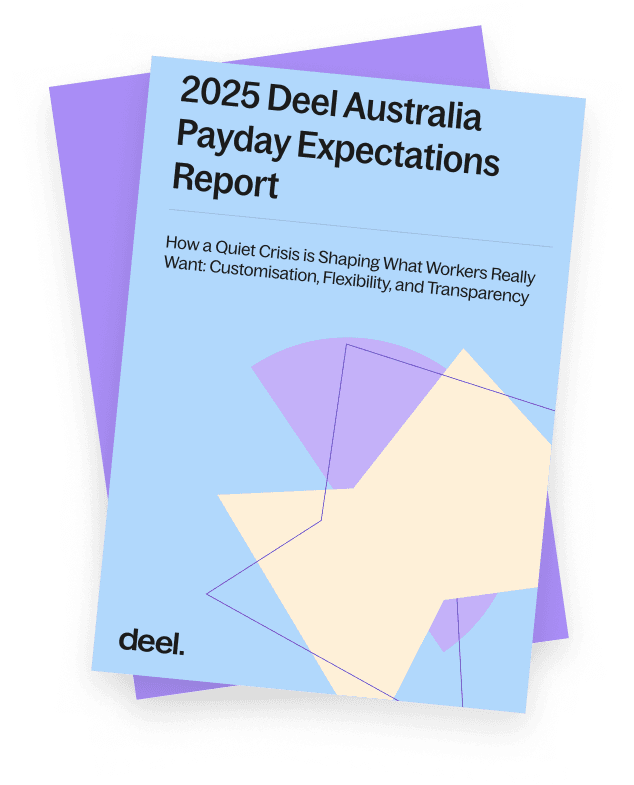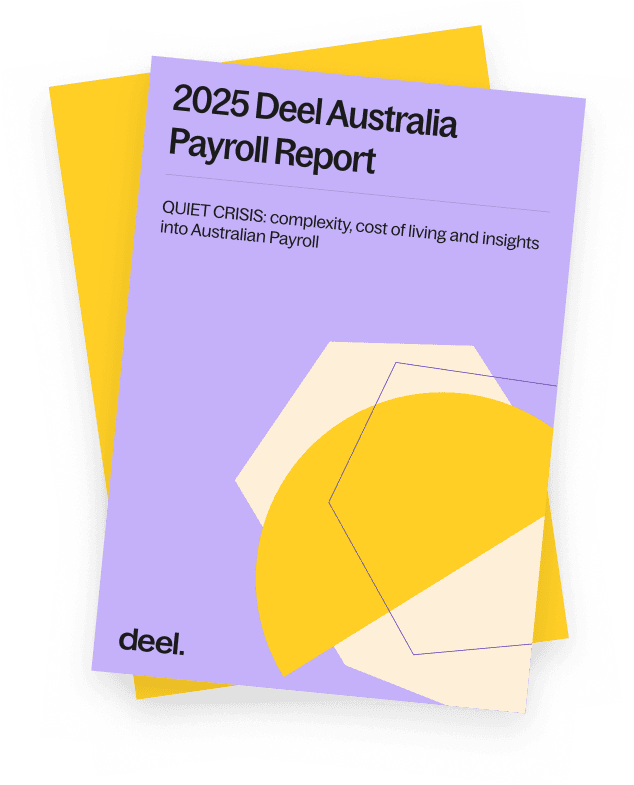Article
8 min read
Australia Payroll Compliance Guide: Taxes and Best Practices
Global payroll

Author
Joanne Lee
Last Update
October 28, 2025

Table of Contents
Why hire in Australia?
Navigating Australia payroll tax
Types of Australia payroll tax
Best practices for maintaining Australia payroll compliance
Maintain compliance in Australia with Deel Payroll
Key takeaways
- With strong trade ties and a low 4.3% unemployment rate, Australia offers access to a highly skilled workforce.
- Australia payroll tax varies by state and territory, and employers are responsible for determining their tax liability. Other types of payroll taxes employers are responsible for include PAYG withholding, superannuation, and fringe benefits tax.
- Deel Payroll streamlines international payroll and automates payroll compliance monitoring, so you can drive business growth in Australia with confidence.
Expanding your business to Australia opens the door to a thriving, highly skilled workforce and seamless access to major global markets through robust trade agreements, but navigating the country’s unique payroll tax system presents significant challenges for even the most seasoned global businesses.
Complexities like state-by-state payroll tax thresholds, multifaceted withholding obligations, and the steep rates of fringe benefits tax can create compliance headaches and administrative burden.
In this article, we break down the must-know Australia payroll tax rules and provide best practices for maintaining compliance. With our proven support, your team can operate confidently in Australia, enjoying the market’s strategic advantages while keeping payroll risk at bay.
There’s no question about the integrity and accuracy of the data or reporting. We have no doubt that we’re compliant with our requirements for superannuation, reporting, PAYG and so on.
—Heather Hall,
Director of Business Services, Family Care
Why hire in Australia?
Australia may be on a far corner of the globe, but it’s hardly isolated. In fact, they’re highly connected with many major economies through free-trade agreements, including the UK, India, China, Japan, Chile, Malaysia, Singapore, Thailand, South Korea, Hong Kong, and more—paving the way for businesses to tap into streamlined trade and investment channels.
Australia also boasts of a deeply skilled workforce and low unemployment, standing at an impressive 4.3% unemployment rate as of September 2025.
Their economy is anchored by a robust services sector and includes surges in MedTech and FinTech while nationally pushing toward net‑zero carbon and clean energy. For expanding companies, having a presence in Australia isn’t just smart, but it also enhances sustainability credentials and corporate reputation.
Navigating Australia payroll tax
Hiring talent in Australia is a strong move for growth, but it comes with its own set of challenges. A new government and a new set of cultural norms mean you’ll need to learn new rules and regulations.
Australia payroll tax is a state- and territory-level tax based on total wages paid by employers, and it’s managed differently by each jurisdiction. It is self-assessed, meaning employers are responsible for determining whether or not they are required to register for payroll taxes.
The minimum thresholds and rates for Australia payroll tax vary depending on the state or territory your business operates in. At a glance, here are the thresholds for each state and territory in Australian dollars.
- Australian Capital Territory: $166,666 monthly threshold
- New South Wales: $1,200,000 annual threshold
- Northern Territory: $208,333 monthly threshold
- Queensland: $108,333 monthly threshold
- South Australia: $125,000 monthly threshold
- Tasmania: $1,250,000 annual threshold
- Victoria: $83,333 monthly threshold
- Western Australia: $83,333 monthly threshold
Employers must register for Australia payroll tax if their total wages paid exceed these thresholds in the respective state or territory. These payroll taxes fund services like health, public safety, education, and law and order.
Regardless of the state or territory, employers in Australia are required to:
- Register for payroll tax online if liable
- Calculate, pay, and report payroll tax on a monthly, quarterly, or annual cycle (frequency depends on the state or territory)
- Conduct an annual reconciliation to verify you’ve paid the correct tax liability and submit it by the deadline in July (exact due date varies based on state or territory)
- Pay penalty taxes if you’ve underreported payroll taxes or failed to maintain compliance

Types of Australia payroll tax
In addition to Australia’s payroll tax scheme, employers are also responsible for pay-as-you-go (PAYG) withholding, superannuation, and fringe benefits tax.
PAYG withholding
Australia uses a familiar, Pay As You Go (PAYG) tax structure to assess individual income tax. Employers are required to withhold tax from employee paychecks and pay those withholdings to the Australian Taxation Office (ATO) by the quarterly due date (generally 28 days after the end of the quarter). This system ensures that individuals fulfill their tax obligations throughout the year instead of in one lump sum.
With this PAYG system, it’s common for individuals to receive a tax refund each year, which acts as a nice incentive for people to complete their tax return.
To conduct PAYG withholding compliantly, employers must register for withholding, provide employees with details about withholding amounts in pay slips and payment summaries, and report all withheld amounts. Refer to these tax tables from the Australian Taxation Office to determine how much to withhold.
Superannuation
Superannuation (or ‘super’ for short) is Australia’s retirement fund. Similar to social security systems in other countries, compulsory withholding is taken for every payroll cycle during an individual's working years.
The money is saved in a super account (known as the ‘super guarantee’) to provide financial support when you retire or turn 65 years old.
As of July 2022, superannuation withholdings apply to all employees aged 18 or older, regardless of how much they are paid. Super also applies to any working individual below the age of 18 who works more than 30 hours per week.
Super payments must be submitted quarterly. In 2025, the due dates follow the below schedule:
- Q1 (July 1 - Sept 30): October 28
- Q2 (Oct 1 - Dec 31): January 28
- Q3 (Jan 1 - March 31): April 28
- Q4 (April 1 - June 30): July 28
You also have the option to make payments more frequently (such as fortnightly or monthly), but you must ensure that you pay your total super contribution by the quarterly due date.
Fringe benefits tax
Fringe benefits are perks given to employees in a different form than salary or wages, and these benefits are taxable in Australia.
Definitions can get confusing when it comes to who can receive a fringe benefit and what constitutes a fringe benefit.
For example, the definition of an employee is broad under fringe benefits tax regulations. It can cover anyone receiving a fringe benefit, including current, future, or past employees as well as company directors and trust beneficiaries working in the company.
However, sole traders and partners in a partnership are not classified as employees, and benefits they provide to themselves are not subject to fringe benefit tax.
Here are common examples of fringe benefits:
- Driving a company car for personal use
- Employee discounts on loans
- Gym memberships, event tickets, and other leisure perks
- Tuition or education-related reimbursements
- Salary sacrifice arrangements
Here are examples of what is not considered a fringe benefit:
- Salary and wages
- Employer contributions to superannuation funds
- Shares or rights provided under approved acquisition schemes
- Employment termination payments
- Dividends
- Benefits given to volunteers and contractors
The fringe benefits tax rate is an astounding 47% of the gross value of the fringe benefits. Considering the tax burden, these job perks come at quite the cost. However, employers can claim an income tax deduction for the fringe benefit taxes they’re required to pay.

Report
2025 Deel Australia Payday Expectations Report
Best practices for maintaining Australia payroll compliance
Staying compliant with Australia’s payroll requirements demands more than knowing the tax thresholds and types of payroll taxes. It requires strong processes, clear documentation, and constant awareness of local updates. Here are several best practices for HR, finance, and payroll leaders to ensure compliance and streamline payroll operations in Australia.
1. Stay updated on changing payroll tax thresholds and rates
Payroll tax in Australia is regulated at the state and territory level, which means rates and thresholds can change independently across jurisdictions. Payroll managers should review the latest guidance from each state’s revenue office at least quarterly and update payroll systems to avoid costly penalties. Between 2024-2025, the Australian Taxation Office collected a total of $1.16 billion in penalties from businesses.
Automated alerts or subscriptions to ATO, state revenue bulletins, and partnering with a global payroll provider can help you stay ahead of the latest regulation changes.
Continuous Compliance™
2. Invest in payroll automation software
Australia allows for various pay frequencies (weekly, fortnightly, or monthly), but reporting obligations like PAYG withholding and superannuation must align with unique deadlines. Establishing a standardized pay period across your Australian workforce introduces administrative complexity and opportunity for errors, creating challenges when submitting payments and reports to the ATO.
Investing in payroll automation software eliminates manual tasks while ensuring accuracy, leading to faster payments to your employees and streamlined documentation.
3. Integrate payroll, accounting, and HR systems
A common source of compliance errors in Australia payroll arises from inconsistent or outdated data. Discrepancies between payroll, accounting, and HR systems causes inaccuracies in tax withholding, superannuation contributions, and employee classifications—increasing the risk of non-compliance and costly penalties.
Integrating your payroll, accounting, and HR systems not only ensures data accuracy and consistency, but it also increases operational efficiency by helping each department collaborate seamlessly without roadblocks caused by varying numbers and confusing spreadsheets.
4. Keep meticulous employee records
Employers must retain payroll and employment records for five to seven years, including details of wages, superannuation payments, leave entitlements, and PAYG withholding. Using cloud-based payroll software with audit-ready data trails helps minimize the risk of missing or inconsistent records, particularly for distributed or hybrid teams.
Maintain compliance in Australia with Deel Payroll
Hiring in Australia can offer significant benefits to global businesses. The challenge is figuring out the rates that apply to each employee and who to pay the liabilities to, all while staying compliant with evolving local requirements.
Deel Payroll streamlines international payroll with local experts in 100+ countries and automated payroll compliance monitoring, so you can expand your business to new countries like Australia with peace of mind.
Request a free, 30-minute demo to learn more about how our solutions can help your business expand while maintaining compliance.

This content is for informational purposes only and does not constitute legal or tax advice.
FAQs
What is the most common pay period in Australia?
Most employers in Australia pay employees weekly or fortnightly, though monthly pay cycles are also permitted. The chosen pay period must align with the organization’s payroll tax and reporting obligations, and employees should receive pay slips within one working day of payment.
How is payroll tax calculated in Australia?
Payroll tax is calculated based on total wages paid by an employer and varies by state or territory. Each jurisdiction sets its own thresholds and rates, and businesses must register once their wages exceed the applicable limit.
Employers are required to self-assess their payroll tax, make necessary payments (on a monthly, quarterly, or annual basis depending on jurisdiction), and conduct an annual reconciliation to verify all taxes were properly paid.
What are employers’ responsibilities for superannuation?
Employers are required to contribute a percentage of each employee’s earnings to their superannuation fund, known as the Superannuation Guarantee (SG). As of July 2025, the SG rate is 12%, and contributions must be paid at least quarterly. Failing to pay super on time can lead to penalties and additional charges from the ATO.
What are common payroll compliance mistakes in Australia?
Frequent issues include failing to register for payroll tax in the correct state, misclassifying workers as contractors, underpaying superannuation, or missing PAYG reporting deadlines. Another common pitfall is overlooking payroll tax obligations for employees working across multiple states or territories.
How can global companies simplify Australia payroll?
Global companies can simplify Australia payroll management by using global payroll platforms like Deel, which automate local compliance checks, manage multi-currency payments, and ensure accurate tax and superannuation calculations. This eliminates manual error and keeps HR and finance teams focused on strategy rather than administration.

Joanne Lee is a content marketing professional with 6+ years of experience creating effective social, search, email, and blog content for companies ranging from start-ups to large corporations. She's passionate about finding creative ways to tell a purpose-driven story, staying active at the gym, and diversity and inclusion. At Deel, she specializes in writing about topics related to global payroll.













